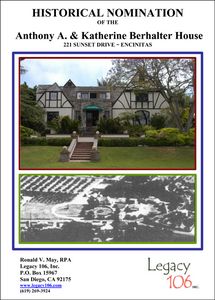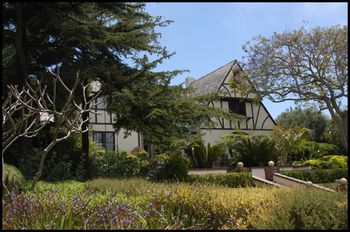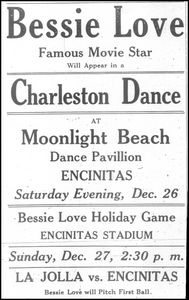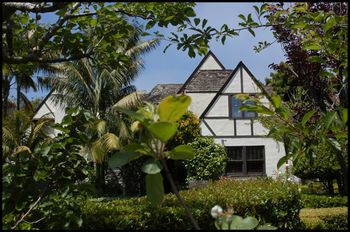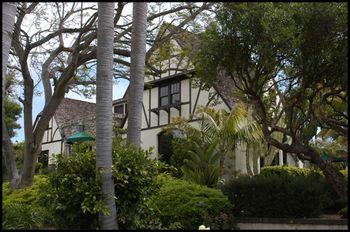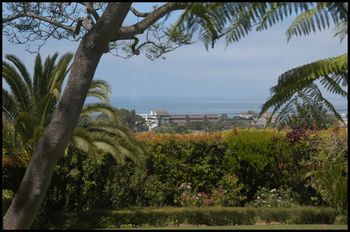|
|
 |
|
|
Historical Landmark No. 1 Encinitas Community Historical Landmark No. 1 - Designated December 2005 |
|
|
| ||
|
|
The Anthony A. and Katherine Berhalter House, so named in recognition of its first owners, is important foremost because of its architecture. It is an excellent example of English Tudor style that today lends a sense of old world grandeur that is part of the community’s historical character. The Current owners removed a wall coating and exposed handwriting they interpreted to read as, “Frank Buck, Encinitas from Orange, CAL, July 29, 1926.” | |
|
|
The house and its architecture are part of the legacy of the rural built environment within the context of the real estate “boom” of the community of Encinitas during the 1920s up until the Great Depression. This growth reflected the shift of dependence from well water with the formation of the San Dieguito Irrigation District in 1923-24. Water was the key to changing Encinitas from a dry farming agricultural community to a suburban residential resort community. Among the earliest real estate subdivisions in Encinitas to take advantage of potable water served by the District was Seaside Gardens, which absorbed former agricultural lands along the coast. | ||
|
|
The Encinitas Historical Society Downtown Walk lists this residence as the “Bliss House.” In 1980, RECON conducted a National Register Survey that listed this house as potentially eligible to the National Register. There can be little doubt that the 1912 vintage Stratford Inn of Del Mar probably inspired most of the Old English Tudor houses in Encinitas. The 1925 renovation of the Inn may have increased its popularity as well. Today, the residences built in this style help define the interesting character of the communities that follow scenic Highway 101 along the southern California coast. | |
|
|
During the Roaring ‘20s, thousands of weekend tourists drove south from Los Angeles and Hollywood on Highway 101 to recreate along the coast. Encinitas proved to be a good stop for travelers, many who stayed over in local hotels. Encinitas boasted the largest baseball stadium on the west coast in 1925 and the Moonlight Beach dance pavilion were big drawing attractions to Encinitas, both of which brought famous Hollywood celebrities. | ||
|
|
The first owner-occupants of 221 Encinitas were Anthony A. and Katherine Berhalter, and their son, Howard. Anthony emigrated from Germany and Katherine (some records spell it Catherine) came from Czechoslovakia. Howard was born in 1913 in Chicago, Illinois, where Anthony worked as a grocer. Katherine was co-owner of the bakery-grocery business. The Berhalters first bought ten acres in Seaside Gardens with the intent of building a home. Deed records show they bought two lots in Seaside Gardens Annex along with 35 acres in the South Coast Park resubdivision of Eatonville which they planned to resubdivide and sell the individual lots as a business venture. | ||
|
|
On November 20, 1935, the Berhalter’s sold the lots to Alice Suter Bachmann. The Berhalter’s notarized the transaction in Chicago, so evidently they were not living in Encinitas at this time. Emmanuel was president of the Pacific Irrigation and Supply Company in Encinitas, which he founded in 1928. He and Alice also had a home in Los Angeles, but he operated an outlet in Encinitas with Augustus “Gus” R. Von Heymann (Vonheyman) as manager. They also owned an avocado ranch in Encinitas that Emmanuel furnished with an irrigation system from the Pacific Irrigation Company. The company supplied overhead irrigation systems, pipe line construction, and shop welding services along with general supplies such as fertilizer, garden hoses and fittings, sprinklers, pipes, and valves. Today, The Emanuel Bachman Foundation is a generous nonprofit charitable philanthropic organization based in Los Angeles. | |
|
|
Historians of Encinitas seem to have overlooked the contributions of Irene M. McIntosh and her family in the shaping of the community’s development. This study has uncovered the forgotten tale of this interesting widow who came from many places and had many faces: wife, mother, widow, daughter, real estate developer, restaurant proprietor, and civic leader. The mystery of her involvement in the community deepens with each new clue uncovered about her activities. The mystery begins with one fact; Irene M. McIntosh owned Seaside Gardens. The chronology of the Seaside Gardens Maps leaves tantalizing clues to how and by whom the subdivision was created. At first blush, one would suppose that Seaside Gardens Annex was probably created sometime, perhaps a few years, after the coastal Seaside Gardens tract. An examination of the subdivision maps gives a great surprise to this theory. They were, in fact, recorded the same day, only one minute apart. Five women, Amelia Bridges, Esther Cullen, Cora Taylor, Irene McIntosh, and her daughter, Irredell Hall, were all involved. | ||
|
|
Mrs. Irene M. McIntosh was born Irene Mary Thompson on October 29, 1868 in Pennsylvania. Her mother was Sarah D. Scott Thompson. Her father’s name is not known at this time but he was born in Ireland. She married Phinty McIntosh who was born in Maine in 1860. In 1900 they lived in Richland, Allegheny County, Pennsylvania where Phinty was an Oil Operator. Sometime after 1920, Irene’s circumstances changed dramatically, and she become a property owner, developer, and realtor. Her daughter, Irredell, married Newell C. Hall in Ohio and they had two children. Newell was a farmer who apparently passed away within a few years, as newspaper accounts identified her as a widow in 1924. By 1930, Irene bought the Blue Goose Café on the highway in South Coast Park from Mrs. Jesse Shreve of Mission Hills. She arranged for Mr. and Mrs. Henry Beck to operate the restaurant. | |
|
|
Amelia Cecilia Timken Bridges and Appleton Shaw Bridges Amelia C. and A.S. Bridges were wealthy property owners from San Diego at the time Amelia acquired land in Encinitas with McIntosh and Hall. History has obscured much of the record of the women who were real estate investors in the 1920s, often to defer the accomplishments to their husbands. Amelia Celia Timken was born in 1855 to Henry G. Timken and Frederica Heinzelmann Timken of Canton, Ohio. They were German immigrants who developed the Timken Roller Bearing Axle Company, a highly successful business that manufactured carriages and buggies in St. Louis, Missouri. Amelia married Appleton Shaw Bridges in St. Louis, Missouri on April 5, 1878. Appleton had business interests with Amelia’s father in Canton, Ohio and they moved to San Diego sometime after 1896. Appleton became the president of the Timken Investment Company and together they devoted their interests to real estate, philanthropy, oil drilling, and other endeavors. Much more research is needed to understand the relationships that connected these women investors. | |
|
|
Biographical information for Amelia Timken Bridges is far more abundant than for Esther Cullen or Cora A. Taylor. Esther was married to J. Frank Cullen who bought a large land tract in San Elijo in 1909 that became Cardiff-by-the-Sea. Little is known about Cora A. Taylor or her relationship to the other women. We do know that her name showed up on every block of lots in Seaside Gardens in the early stages of development. Permission to use this material is granted provided it is attributed as follows: Copyright © 2010 Ronald V. May and Dale Ballou May, Legacy 106, Inc., www.legacy106.com | ||
|
|
Home | Designations | Qualifications | Company Profile | Newsletter | Links Archaeology
& Historic Preservation www.legacy106.com |
|


